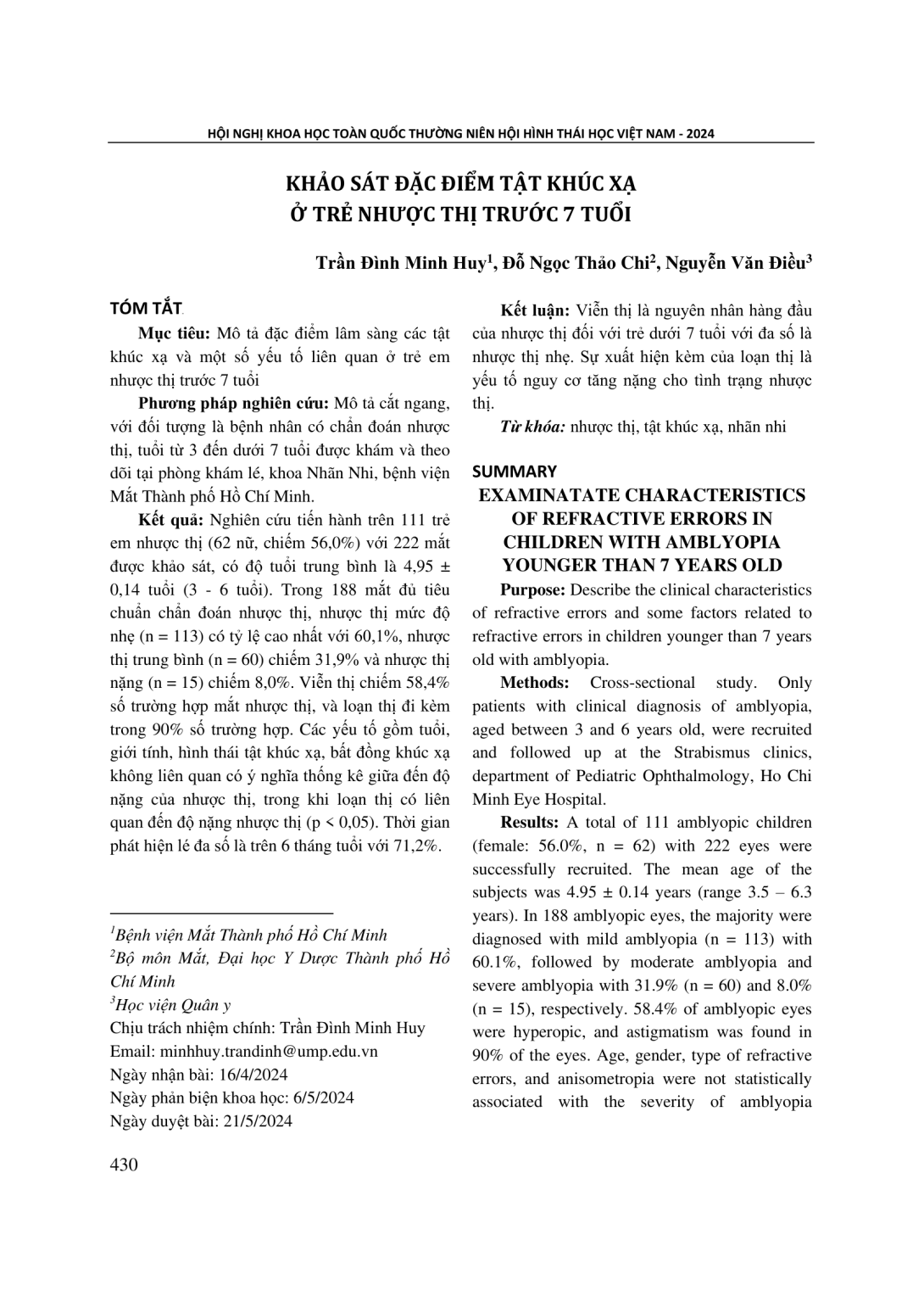
Mô tả đặc điểm lâm sàng các tật khúc xạ và một số yếu tố liên quan ở trẻ em nhược thị trước 7 tuổi Phương pháp nghiên cứu: Mô tả cắt ngang, với đối tượng là bệnh nhân có chẩn đoán nhược thị, tuổi từ 3 đến dưới 7 tuổi được khám và theo dõi tại phòng khám lé, khoa Nhãn Nhi, bệnh viện Mắt Thành phố Hồ Chí Minh. Kết quả: Nghiên cứu tiến hành trên 111 trẻ em nhược thị (62 nữ, chiếm 56,0%) với 222 mắt được khảo sát, có độ tuổi trung bình là 4,95 ± 0,14 tuổi (3 - 6 tuổi). Trong 188 mắt đủ tiêu chuẩn chẩn đoán nhược thị, nhược thị mức độ nhẹ (n = 113) có tỷ lệ cao nhất với 60,1%, nhược thị trung bình (n = 60) chiếm 31,9% và nhược thị nặng (n = 15) chiếm 8,0%. Viễn thị chiếm 58,4% số trường hợp mắt nhược thị, và loạn thị đi kèm trong 90% số trường hợp. Các yếu tố gồm tuổi, giới tính, hình thái tật khúc xạ, bất đồng khúc xạ không liên quan có ý nghĩa thống kê giữa đến độ nặng của nhược thị, trong khi loạn thị có liên quan đến độ nặng nhược thị (p < 0,05). Thời gian phát hiện lé đa số là trên 6 tháng tuổi với 71,2%. Kết luận: Viễn thị là nguyên nhân hàng đầu của nhược thị đối với trẻ dưới 7 tuổi với đa số là nhược thị nhẹ. Sự xuất hiện kèm của loạn thị là yếu tố nguy cơ tăng nặng cho tình trạng nhược thị.
Describe the clinical characteristics of refractive errors and some factors related to refractive errors in children younger than 7 years old with amblyopia. Methods: Cross-sectional study. Only patients with clinical diagnosis of amblyopia, aged between 3 and 6 years old, were recruited and followed up at the Strabismus clinics, department of Pediatric Ophthalmology, Ho Chi Minh Eye Hospital. Results: A total of 111 amblyopic children (female: 56.0%, n = 62) with 222 eyes were successfully recruited. The mean age of the subjects was 4.95 ± 0.14 years (range 3.5 – 6.3 years). In 188 amblyopic eyes, the majority were diagnosed with mild amblyopia (n = 113) with 60.1%, followed by moderate amblyopia and severe amblyopia with 31.9% (n = 60) and 8.0% (n = 15), respectively. 58.4% of amblyopic eyes were hyperopic, and astigmatism was found in 90% of the eyes. Age, gender, type of refractive errors, and anisometropia were not statistically associated with the severity of amblyopia although astigmatism was (p<0.05). The severeness of amblyopia is associated with the severity of astigmatism (p < 0,05). The diffenrence between anisometropia and the level of amblyopia is not significant (p > 0.05). Most of the participants were diagnosed with strabismus for more than 6 months. Conclusion: Hyperopia remained the main refractive errors related to amblyopia in children younger than 7 years old and the majority of the participants had mild amblyopia. Astigmatism appeared to be associated with the severity of amblyopia.
- Đăng nhập để gửi ý kiến
